Passions Run Dry in India’s ‘Army Villages’ Since the Launch of Agnipath Scheme
Hisar/Jind (Haryana): "I had only two acres of land. My son was passionate about joining the army. He was preparing for it for the past 4-5 years. Then, the Agniveer Scheme was launched in 2022. Suddenly, he expressed his desire to go abroad. He thought it was better to go abroad than joining the army for four years. All his passion subsided in one go. We sold our quarter acre of land and sent him to Cyprus just a week ago," said Yashpal Maurya, a resident of Bas village in western Haryana's Hisar district. He sent his son Lalit abroad in February 2024. Lalit had just turned 18; growing up, he had wanted to join the army. Though he was eligible, he was no longer passionate about it.
This is the story of many youth in several villages across the country that have earned the sobriquet ‘army villages’ or ‘villages of soldiers’. For the last several decades, joining the Army has been a passion and the preferred career choice for boys in these villages. Thousands of youth from these villages have served the country by joining the army. An exposure to army life has given direction to the economy and social structure of these areas. But after the Agneepath scheme was introduced, the situation changed suddenly.
How has the Agniveer scheme affected the lives of youth in villages known as army villages? Will these villages no longer be called as such? What are the youth in these villages doing now after their only dream about their career has been shattered? Does the army need this scheme? Is this an essential step for modernisation of the army?
To answer these questions, The Wire visited many such areas of the country. The first instalment in this series is from Haryana.
Almost every family has a member in the army, but boys have stopped preparing for it
Migration to foreign countries is quite common among the youth in Haryana. But residents of several villages in Jind, Hisar and Bhiwani districts of Haryana have never found migration to foreign countries to be a lucrative option. The youth here have been joining the army since the time of the Azad Hind Fauj. At the entrance of villages like Baroda, Bhongra, Karasindhu and Bas, memorials of martyred soldiers can be easily seen, offering an insight into the backdrop of the area before one enters it. Till two years ago, the boys of these villages aspired to join the army after passing 10th grade. But after the introduction of the Agneepath scheme, this trend has witnessed a sudden shift.
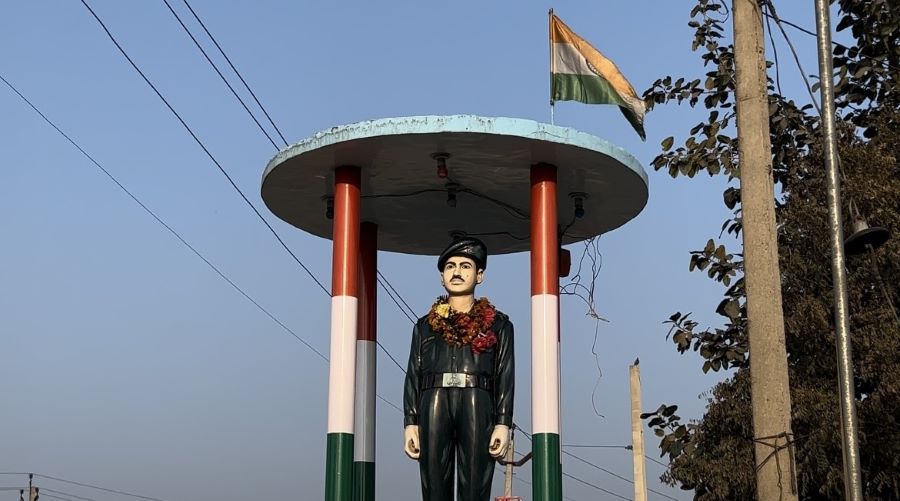
Martyr memorial in a Haryana village. Photo: Rishikesh Kumar
According to the sarpanch of these villages, more than a thousand youth have gone abroad in the last two years, most of whom were earlier preparing for the army. Besides, many youth have got their passports and are waiting for visas or are looking to cross borders through the donkey route, that is, illegally. For many years, a large number of people from Punjab and Haryana have been reaching countries like the US, UK, and Australia illegally traversing forests, mountains and rivers.
62-year-old Ranveer Singh, who was playing cards with a group of 10 people at the square of Jind's Bhongra village, proudly said, "Here, everyone joins the army. I have been in the Jat Regiment too." Pointing towards four other people, he said that they had also served in the army.
What is the situation now?
On hearing this, a sense of disappointment pervades the gathering.
Singh said that till two years ago, children could be seen playing in the grounds and running on roads even in the afternoon, but now no one is there even in the morning and evening. The young are getting passports and moving abroad.
Nearly 1-2 passport verifications every day
The population of Jind’s Baroda village is above 20,000. 50-year-old sarpanch Resham Singh said that from the time of the Azad Hind Fauj to now, more than 1,000 residents of this village have served in the army. Due to their passion for the army, the boys did not opt for para-military or Haryana Police even after the Agniveer scheme was introduced.
According to him, he receives one or two passports for verification every day. "During the last two years, about 500 youth from this village have gone abroad. A large number of them were preparing for army recruitment," said Singh.
According to Resham, most of the youth travelling abroad opt for the donkey route. Citing unemployment as the reason, he said, "If they don't go, they will starve here."
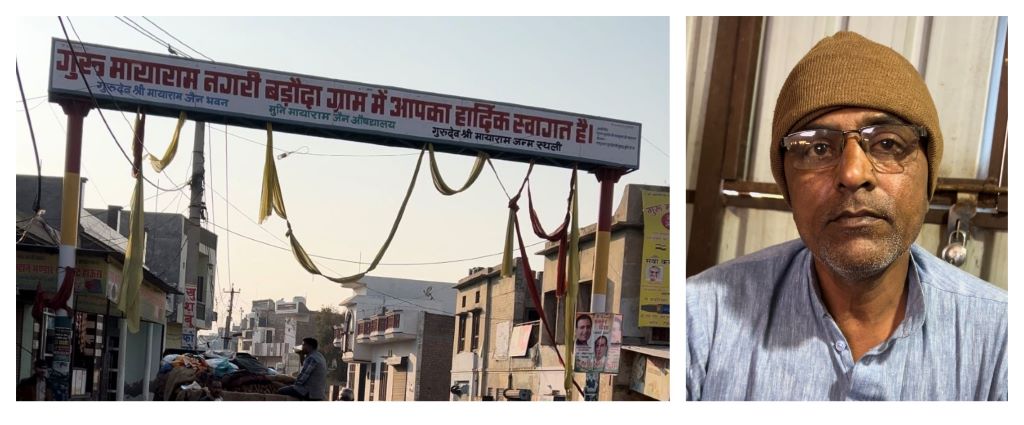
Resham Singh. Photo: Rishikesh Kumar
Jyoti Maurya, sarpanch of Badshahpur Panchayat of Bas village, said, ‘Boys from families of farmers or labourers join the army. It was a decent job after 10th grade. What will they do now? By now, 30 boys from my Panchayat area alone have gone abroad.’
In Bas village, which has a population of more than 35,000, about 3,000 people have served or are serving in the army. Men from this village have also served as senior officers in the army. But now the situation has changed.
Both the sons of Talwar Singh prepared for the army and had even submitted Agniveer's form but Talwar Singh refused to grant them permission. Later, both of them went to the US where his elder son is a truck driver and the younger one works as a daily wage labourer. When asked how he managed to get the visas so quickly, he smirked and said, "Go and find out how it must have transpired!"
Clearly, the youth who once aspired to join the army are travelling abroad through the donkey route.
However, while talking to The Wire, the Deputy Commissioner of Jind, Mohd Imran Raza rejected this outright. "I have not received any such information or complaint that the youth are migrating to foreign countries due to any scheme. This is completely baseless. We do not have any data available on it. Therefore, I would not like to comment on it. The youth are already interested in going abroad from here. So, it cannot be claimed that it is only because of Agniveer," Raza said.
On the contrary, Hisar Deputy Commissioner Pradeep Dahiya indicated that the youth are migrating. "I have recently assumed my charge, so I do not have any information about it. Nor have these things ever been discussed on any forum. As far as migration is concerned, there can be many reasons for it. People migrate in search of better prospects. Those preparing (for the army) are also doing it."
'Postponed' recruitment
When army recruitment was halted after the implementation of Agniveer, it shattered the dreams of these youth in one fell swoop. Suresh Chahal, a resident of Baroda village, said that his 22-year-old son Ankit Chahal was good at his studies. Halting his army preparation, he obtained a study visa and migrated to the US.
The army recruitment process for 2020-21 was almost complete. A written examination was scheduled for the Army and appointment letters were to be given to the selected candidates of the Navy and Air Force, but there was a delay due to Covid. However, the Agneepath scheme was announced in June 2022, and the test and selection procedure remained incomplete.
When candidates went to the court, the Union Government told the Supreme Court that this recruitment has not been cancelled but has been postponed. As a result, the candidates still have some hope. Dozens of youth in these villages are waiting for the resumption of army recruitment.
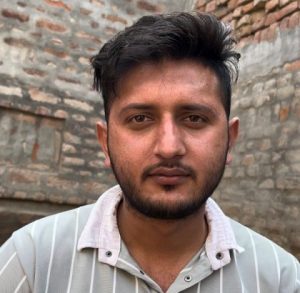
Sunil Chahal. Photo: Rishikesh Kumar
Twenty-three-year-old Sunil Chahal of Bhongra village had passed the medical examination for the recruitment process. Since he was an NCC cadet, he would have been exempted from the written examination. His childhood dream was about to be fulfilled when the Agneepath scheme arrived – recruitment was cancelled and his dream remained unfulfilled. With his passport in his hand, he said that the only option left for him now is to go abroad. "I am in touch with friends who have already left the country and discussing with them which country would be better for me."
Ankit Chahal, a resident of Bhongra, is in a similar dilemma. He had prepared for the army and got selected too but his recruitment was cancelled. Ankit is now trying to get a visa.
Hundreds of youth from neighbouring villages have joined the army by practising running in the grounds of Rajiv Gandhi College in Uchana village of Jind. Ramesh Chahal, who handles the maintenance of the ground, said that "250-300 children used to come here to run every day. But everything changed in the last two years. The 5-10 people who can be seen here today have not been recruited. They are here only for the sake of fitness."
The grounds in a village in Uchana, which were usually buzzing with youth preparing to join the army, now have very few visitors.
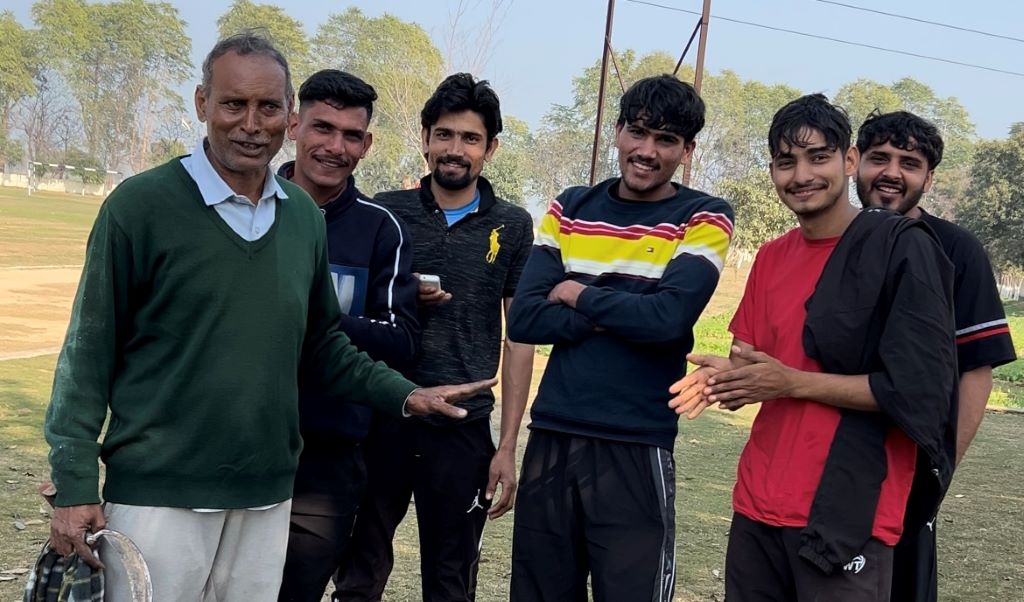
Youth at the ground in Uchana village along with the caretaker. Photo: Rishikesh Kumar
After Agniveer, Haryana's participation in the army has reduced by more than 70%
According to defence ministry data presented in the Lok Sabha in February 2022, 5,097 candidates from Haryana were selected in the army recruitment held in 2019-20. Haryana accounts for only 2% of India's total population, but the state's participation in army recruitment was 6%. That year only three states had a better ratio than Haryana – Himachal Pradesh, Uttarakhand and Punjab.
The population of Himachal Pradesh is only 1% of the total population of the country, but its participation was 7%. Similarly, despite having 1% population, Uttarakhand accounted for 5% participation in the army. The population of Punjab is only 2% of the total population of the country, but the participation of Punjab was 10%.
According to local estimates, this average in Haryana's districts like Jind, Bhiwani and Hisar is more than double the state average. Rajya Sabha MP Deependra Singh Hooda told The Wire that he has raised the issue of Agniveer in the Rajya Sabha.
Hooda said that since the arrival of Agniveer, the participation of Haryana's youth in the army has reduced by more than 70%. In his speech in the Rajya Sabha in February, he had raised the issue of unemployment prevalent in Haryana and said that the unemployed youth of this state are forced to migrate abroad. He criticised the Agneepath scheme and said that earlier there used to be 5,500 confirmed recruitments from Haryana every year, but now only 900 youth are being recruited.
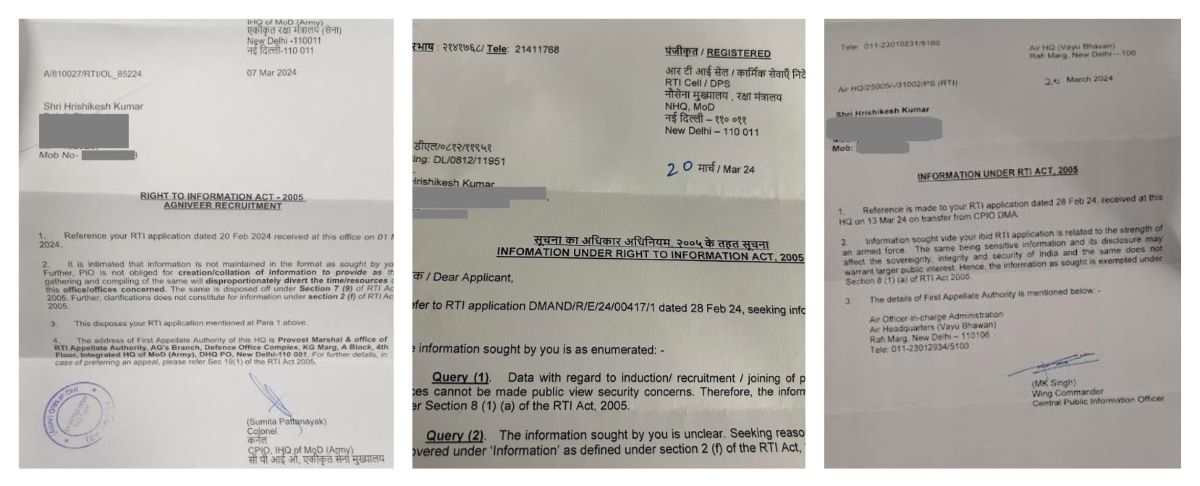
RTI responses received by The Wire.
In response to The Wire's query to the defence ministry via an RTI, requesting the number of recruitments from each state, the ministry refused to reveal this information saying, "..the PIO is not obliged for creation/collation of information to provide as the gathering and compiling of the same will disproportionately divert the time and resources of this office/officers concerned."
The Air Force wrote, "The information sought is related to the capabilities of an armed force. The same being sensitive information and its disclosure may affect the sovereignty, integrity and security of India and the same does not warrant larger public interest."
Meanwhile, the Navy replied that "data related to appointment/recruitment/joining of personnel in the armed forces cannot be made public in view of security reasons."
The Wire asked the Ambala headquarters for the number of candidates selected in the last five years, but did not receive any response.
Many coaching centres for army preparation close down
Milkha Grewal, a resident of Rohtak, used to run a coaching centre to help those preparing for army recruitment. He has stopped offering coaching now. He said that after six months of Agniveer's arrival, only 15-20 candidates were left in his coaching. Earlier this number used to be 200-250. It was not possible for him to run the coaching at this rate.
Many other coaching classes have met a similar fate, he said. "Some coaching classes are still functional, where hardly 30-40 boys can be found. Now, everyone has stopped preparing for army and is busy with IELTS. There is more competition among them to go abroad now."
Gaurav Kumar, who runs his immigration office in Karnal, confirmed it. According to him, "Earlier, youth in villages used to prepare for army recruitment after 10th and 12th. Now they are seen pursuing IELTS and PTE."
More than 2 lakh police clearance certificates issued in last year and a half
No organisation has any accurate data regarding migration abroad. A Haryana Police official said that in the last one and a half years, at least more than 2 lakh police clearance certificates have been issued in Ambala and surrounding districts of Jind, Hisar, Bhiwani, Rohtak, Kaithal, and Karnal.
Police clearance certificates are issued to those who are applying for a job or long-term visa abroad. But a larger number of people are going illegally, for which no data is available.
Agents running the immigration office claim that the waiting list to get the passport in Ambala is so long that people apply from Jaipur, Chandigarh and Delhi for it. "There are 835 appointments for passport every day in Ambala and Chandigarh. If someone needs it urgently, they turn to Jaipur or Delhi," said an agent.
The number of people going abroad through the 'Dunki' route increase
The British government recently presented a report stating that there has been a rapid increase in the number of Indians coming to the UK illegally.
In 2022, 748 Indians entered Britain by crossing the English Channel, whereas in 2023 this number increased by 50% to 1,192. While 2,612 Indians had sought asylum in 2022, this number jumped to 5,253 in 2023.
Similarly, this number has increased rapidly in America as well. In 2022, 65,000 Indians entered the US border illegally. But in 2023 this figure crossed 1 lakh. More than 60% of those going abroad through the donkey route are youth.
Rishikesh Kumar is an independent journalist.
Translated from the Hindi original by Nausheen Rehman.
This article went live on April twenty-sixth, two thousand twenty four, at zero minutes past six in the evening.The Wire is now on WhatsApp. Follow our channel for sharp analysis and opinions on the latest developments.




